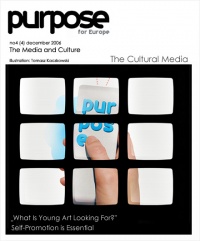
Feature
Cultural Media
I have brought up the problem of „art on the Internet” in a few issues of „Purpose” („Cultural Window Shopping”, „Shaping the Void”), however it is worth throwing a few reflections in the previous analyses. First of all, we should mention internet portals on art (such as http://www.obieg.pl or http://www.purpose.com.pl), and there are more and more of them. Undertakings of this kind are necessary because they offer opportunity for a discussion that enables methodological organization of contemporary artistic and intellectual search. Therefore, the activity of „Purpose” is particularly vital (well, sometimes it is well worth fluttering your employers, particularly if these flatteries have quite objective justification) because it helps young artists find their way in the market reality, makes them aware of the real value of marketing without which contemporary art would be definitely banished.
We can risk a claim that the context of the post-modernistic discussion about art continues in cyberspace. Without the Internet it’s difficult to imagine modern, multimedia artistic undertakings. Is that a good sign? Of course it is because art – as long as we treat it as an area of spiritual, aesthetic experiments that make it possible to define human identity again (in the context of challenges of the socio-economic development of modern societies) – must always be everywhere where something new happens. Art must go further. It must show possible consequences of today’s decisions and ask questions about the future.

illustration: Tomasz Kaczkowski
Everything suggests that cyberspace is our future so we should be happy that there IS art in the Internet. Portals that organize the space of artistic exchange are very popular. We should only make sure that those portals are not too vulnerable to censorship from the top. When Rupert Murdoch took over MySpace, he got rid of all the contents that had the „obscene” character, which was connected with the planned commercialization of the portal. What a shame. Artistic portals should be free from such actions. The artistic milieu can themselves handle the marginalisation of artistic contents. They don’t need any authoritarian decisions (taken by moderators in the name of political correctness or „good taste”).
And what about the presence of art on television? It is much worse here, unfortunately. Obviously, the problem results from the structure of the television itself, from certain economic and technical factors. On the Internet anyone can be the sender of a message (by the way, it is worth mentioning the „Web 2.0” phenomenon – i.e. the new vision of the Internet, expressed by blurred borders between the sender and the receiver), whereas television still remains in the hands of decision-makers. Traditional television is expensive, has a limited number of broadcasting frequencies, so it has to be subject to regulations from the top. Where big money is involved, art is marginalised, so its public presentation has to be guaranteed by law.
The result of such legal restrictions is the content of the channel TVP Kultura. It’s great that such a channel exists, but we cannot ignore the fact that its range of influence is rather scanty. It’s true that cultural programmes have poor audience ratings, in the case of culture however one shouldn’t apply economic criteria. It seems that Public Television still fails to carry out its statutory responsibilities. TVP Kultura should be better promoted, the trailers of its programmes should be shown in prime time in the First and the Second Channels – maybe then the mass viewer will get interested in something else than phone-in quizzes.
Another important problem is the politicized television discourse about art. Unfortunately, pre-election promises to depoliticize public television were just empty slogan. Such programmes as „Ring” by Rafa³ Ziemkiewicz are tinged by a strong outlook on life. You can say that ideological bias cannot be avoided, particularly in the case of author’s programmes. Maybe it’s true, however there are more and more of such „author’s” programmes on television, while there is no space there for authentic debate in which each side would have equal chances to present their concepts, even if the concepts didn’t fit in with the image of the world promoted by the host of the programme. Well, such are the times. Maybe the demand for an authentic television debate is only an impracticable dream of an aesthete?
If the „official media” don’t treat the issues of broadly understood culture more seriously, soon they will lose all credibility. Television will become the domain of pure entertainment, untouched by a deeper reflection. Whatever is important and provocative will get transferred to the Internet. Who knows, maybe digital television will be the solution to the problem of the presence of art in the media? Marketing research makes us optimistic as it shows that products from an artistic niche finds its audience anyway („the long tail phenomenon”). I am confident. Art, like a sniper, will always find a target. Everything depends on the sniper’s eye and professionalism.
Check the archive

nr 27 December 2006
theme of the issue:
MEDIA
< spis treści
Article
Balance
Presentation
Grandpeople
Career in Culture
Self-promotion is essential - conversation with Magnus Helgesen
Culture Industries
Versatile media - Maciej Mazerant
Workshop
Media Programme - Zespół Media Desk
Feature
Cultural Media - Kuba Wandachowicz
On the margin
"Mediacized" reality - interview with Justyna Hofmokl





